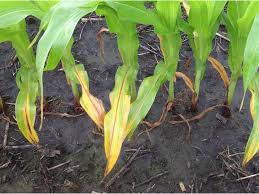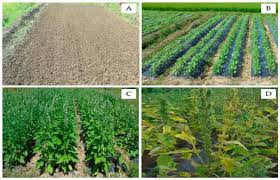Nutrient depletion in continuous cropping is a significant challenge faced by farmers worldwide. As crops are repeatedly planted in the same soil, essential nutrients become exhausted, leading to reduced soil fertility and lower crop yields. Continuous cropping systems often lack the diversity found in crop rotation, which can naturally replenish soil nutrients.
Without adequate management strategies, this cycle of nutrient depletion can create a vicious cycle where declining soil health affects not only crop production but also the long-term sustainability of agricultural practices. This issue is exacerbated by the growing global population and the increasing demand for food, necessitating efficient and effective strategies to maintain soil fertility.
One of the primary strategies to prevent nutrient depletion is implementing a well-planned crop rotation system. By alternating crops with varying nutrient requirements, farmers can enhance soil health. Different plants draw different nutrients from the soil, and rotating crops helps ensure that no single nutrient is excessively depleted. For instance, incorporating legumes in the rotation can be particularly beneficial, as they have the ability to fix atmospheric nitrogen, enriching the soil and reducing the need for synthetic fertilizers.
Another effective strategy is the application of organic amendments such as compost, manure, and cover crops. These organic materials not only provide essential nutrients but also improve soil structure, enhance microbial activity, and increase the soil’s water-holding capacity. Cover crops, planted during fallow periods, help prevent soil erosion, suppress weeds, and contribute organic matter to the soil when incorporated. This approach creates a more balanced nutrient profile, ultimately supporting healthier crop growth in subsequent planting seasons.
Soil testing is another critical component in managing nutrient levels effectively. Regular soil testing allows farmers to identify nutrient deficiencies and adjust their fertilization practices accordingly. By understanding the specific nutrient needs of their crops, farmers can apply fertilizers more efficiently, reducing waste and minimizing the environmental impact of excess nutrient runoff. Precision agriculture technologies, such as GPS and remote sensing, can aid in applying fertilizers and amendments precisely where and when they are needed, further optimizing nutrient use.
Integrating conservation tillage practices can also help mitigate nutrient depletion. Traditional tillage methods can lead to soil erosion, compaction, and the breakdown of organic matter, which are detrimental to soil health. By minimizing soil disturbance and maintaining crop residues on the surface, farmers can enhance soil structure, increase organic matter content, and improve moisture retention. These practices not only support nutrient retention but also contribute to greater resilience against extreme weather conditions.
Education and awareness among farmers about sustainable agricultural practices play a crucial role in addressing nutrient depletion. Extension services, workshops, and online resources can provide valuable information on the best practices for nutrient management. Encouraging farmers to adopt integrated nutrient management strategies combining organic and inorganic fertilizers based on soil tests can lead to improved crop productivity while maintaining soil health.
Importance of Soil Testing and Analysis

1. Understanding Soil Nutrient Levels: Soil testing provides crucial information about the nutrient content of the soil, including macronutrients (nitrogen, phosphorus, potassium) and micronutrients (iron, manganese, zinc). By understanding these levels, farmers can make informed decisions about fertilization and amendments needed to enhance soil fertility.
2. Identifying Soil pH: Soil testing measures pH levels, which is essential for determining soil acidity or alkalinity. The pH affects nutrient availability; for example, certain nutrients are more available in specific pH ranges. Testing helps farmers adjust soil pH through lime or sulfur applications to optimize nutrient uptake.
3. Preventing Nutrient Deficiencies and Toxicities: Regular soil analysis helps in identifying potential nutrient deficiencies or toxicities before they adversely affect crop growth. By addressing these issues early, farmers can improve crop health and yield, minimizing losses associated with nutrient imbalances.
4. Supporting Sustainable Farming Practices: Soil testing promotes sustainable farming by enabling precise nutrient management. Instead of applying fertilizers indiscriminately, farmers can tailor their applications based on test results, reducing environmental impacts such as nutrient runoff into water bodies and lowering input costs.
5. Monitoring Soil Health Over Time: Consistent soil testing allows farmers to monitor changes in soil health over time. By tracking soil organic matter, microbial activity, and nutrient levels, farmers can assess the effectiveness of their soil management practices and make necessary adjustments to enhance soil health.
Implementing Crop Rotation Techniques
1. Breaking Pest and Disease Cycles: Implementing crop rotation is a natural method for disrupting the life cycles of pests and diseases. By changing the crops planted in a specific field, farmers can reduce the population of pests that thrive on specific crops, minimizing the need for chemical pest control.
2. Enhancing Soil Fertility: Different crops have unique nutrient requirements and contribute differently to soil fertility. For example, legumes can fix atmospheric nitrogen, enriching the soil for subsequent crops. This practice reduces the reliance on synthetic fertilizers, promoting a more sustainable approach to agriculture.
3. Improving Soil Structure and Health: Crop rotation helps in maintaining healthy soil structure by promoting diverse root systems. Deep-rooted plants can improve soil aeration and drainage, while different root architectures can prevent soil compaction. Healthier soils lead to improved water infiltration and nutrient availability.
4. Increasing Crop Resilience: A well-planned crop rotation strategy enhances the resilience of agricultural systems to climate change and environmental stresses. By diversifying crop types, farmers can mitigate the risk of crop failures due to pests, diseases, or adverse weather conditions.
5. Optimizing Resource Use: Crop rotation allows for the efficient use of resources such as water, nutrients, and sunlight. Different crops may require varying amounts of these resources at different times, helping to maximize yields while minimizing resource wastage and environmental impact.
Read Also: Causes of Egg Production Reduction in Poultry Farms and Ways to prevent them
Utilizing Cover Crops for Soil Health

1. Improving Soil Structure: Cover crops play a vital role in enhancing soil structure. Their root systems help break up compacted soil, creating channels for air and water movement. This improvement in soil porosity leads to better drainage and root penetration, promoting healthier crop growth.
2. Enhancing Nutrient Cycling: Cover crops contribute to nutrient cycling by adding organic matter to the soil. As they decompose, they release nutrients back into the soil, improving fertility. Certain cover crops, such as legumes, can also fix nitrogen, enriching the soil for subsequent crops.
3. Suppressing Weeds: Cover crops can effectively suppress weed growth by outcompeting them for light, water, and nutrients. Their dense growth can prevent weed seeds from germinating and reduce the need for herbicides, promoting a more sustainable approach to weed management.
4. Erosion Control: Cover crops are essential for controlling soil erosion, particularly during fallow periods. Their foliage protects the soil from rain impact, while roots help anchor the soil, reducing the likelihood of erosion from wind and water. This practice is critical for maintaining soil health and productivity.
5. Enhancing Biodiversity: Utilizing cover crops contributes to increased biodiversity in agricultural systems. By planting diverse cover crops, farmers can support beneficial insects and soil microorganisms, which play important roles in pest management and nutrient cycling, leading to healthier ecosystems.
Applying Organic Amendments to Enhance Nutrient Levels
1. Improving Soil Fertility: Organic amendments, such as compost, manure, and green manure, enrich the soil with essential nutrients like nitrogen, phosphorus, and potassium. They improve soil fertility by slowly releasing nutrients as they decompose, promoting healthy plant growth.
2. Enhancing Soil Structure and Aeration: The application of organic materials enhances soil structure by improving aggregation and porosity. This leads to better aeration and water infiltration, allowing roots to penetrate more easily and access nutrients effectively, which is crucial for crop productivity.
3. Increasing Soil Microbial Activity: Organic amendments provide a food source for beneficial soil microorganisms. These microorganisms play a vital role in nutrient cycling, breaking down organic matter and converting nutrients into forms that plants can easily absorb, thus enhancing overall soil health.
4. Promoting Soil Moisture Retention: Organic materials improve the soil’s ability to retain moisture, reducing the need for frequent irrigation. This is particularly beneficial in arid regions or during dry seasons, helping crops access water and nutrients more efficiently.
5. Reducing Chemical Input Needs: By enhancing nutrient levels and soil health through organic amendments, farmers can reduce their reliance on synthetic fertilizers. This not only lowers input costs but also minimizes the environmental impact associated with chemical fertilizers, promoting more sustainable farming practices.
Integrating Conservation Tillage Practices
1. Reducing Soil Erosion: Conservation tillage practices, such as no-till and reduced-till farming, help minimize soil disturbance, reducing erosion by maintaining soil structure and protecting topsoil. This is essential for preserving soil fertility and preventing the loss of valuable nutrients.
2. Enhancing Soil Moisture Retention: By leaving crop residues on the surface, conservation tillage improves soil moisture retention. This practice allows for better water infiltration and reduces evaporation, ensuring crops have consistent access to moisture throughout their growing season.
3. Supporting Soil Health and Biodiversity: Reduced soil disturbance enhances the habitat for beneficial soil organisms, such as earthworms and microbes. This promotes a diverse soil ecosystem that contributes to nutrient cycling, pest suppression, and overall soil health.
4. Improving Carbon Sequestration: Conservation tillage practices can contribute to carbon sequestration by reducing soil disturbance and preserving organic matter. This helps mitigate climate change by storing carbon in the soil, promoting a more sustainable agricultural system.
5. Enhancing Crop Yields: By integrating conservation tillage, farmers can improve crop yields over time. Healthier soils with better structure, moisture retention, and nutrient availability lead to stronger plant growth and higher productivity.
Read Also: Best Type of Poultry to Raise for Commercial Production and their Time of Maturity
Utilizing Balanced Fertilization Strategies

1. Tailoring Nutrient Applications: Balanced fertilization involves applying the right type and amount of nutrients based on soil tests and specific crop requirements. This ensures that crops receive essential nutrients without excess, optimizing growth and minimizing environmental impacts.
2. Preventing Nutrient Deficiencies: By using a balanced approach, farmers can prevent nutrient deficiencies that can negatively affect crop yields and quality. Adequate supply of macronutrients (N, P, K) and micronutrients (Fe, Zn, Cu) leads to healthier plants and better harvests.
3. Enhancing Soil Fertility: Balanced fertilization strategies help maintain and improve soil fertility over time. By applying nutrients judiciously, farmers can support long-term soil health, which is crucial for sustainable agricultural practices and food production.
4. Reducing Nutrient Runoff: Implementing balanced fertilization reduces the risk of nutrient runoff into water bodies, which can cause pollution and eutrophication. By matching nutrient applications to crop needs, farmers can minimize environmental impacts while promoting healthy crop growth.
5. Supporting Integrated Nutrient Management: Balanced fertilization is a key component of integrated nutrient management, combining organic and inorganic sources to optimize nutrient availability. This holistic approach enhances crop productivity and sustainability by leveraging the benefits of both nutrient sources.
Exploring Nutrient-Saving Technologies
1. Precision Agriculture Tools: Nutrient-saving technologies, such as GPS and remote sensing, enable farmers to monitor nutrient levels and apply fertilizers more accurately. This targeted approach reduces waste, improves nutrient use efficiency, and enhances crop yields.
2. Slow-Release Fertilizers: The use of slow-release or controlled-release fertilizers allows for the gradual availability of nutrients over time. This reduces the frequency of applications and minimizes nutrient leaching, making it an effective strategy for sustainable nutrient management.
3. Soil Moisture Sensors: Implementing soil moisture sensors helps farmers manage irrigation more efficiently, ensuring that crops receive adequate moisture while minimizing water usage. This indirectly supports nutrient uptake, as water availability is crucial for nutrient absorption by plants.
4. Biofertilizers: Utilizing biofertilizers, which contain beneficial microorganisms, can enhance nutrient availability in the soil. These microorganisms help with nutrient cycling, promoting plant growth and reducing the need for synthetic fertilizers.
5. Nutrient Management Software: Advanced software solutions allow farmers to analyze soil data, track nutrient applications, and make informed decisions about fertilization. This technology streamlines nutrient management practices and supports sustainable farming by optimizing input use.
Monitoring and Managing Soil pH Levels
1. Importance of Soil pH: Soil pH is crucial for nutrient availability and microbial activity. Most crops thrive in slightly acidic to neutral pH (6.0-7.0), where nutrients are readily accessible, and beneficial microorganisms can function optimally.
2. Testing Soil pH: Regular soil testing helps determine the current pH level. Farmers can use pH meters, test kits, or send samples to a laboratory for precise measurements, ensuring that they have accurate data for effective management.
3. Adjusting Soil pH: If soil pH is too low (acidic), lime (calcium carbonate) can be added to raise it. Conversely, sulfur or aluminum sulfate can lower pH in alkaline soils. Proper adjustments promote healthy plant growth and improve nutrient uptake.
4. Incorporating Organic Matter: Adding organic materials like compost or well-rotted manure can help buffer pH levels and improve soil structure. Organic matter also enhances microbial activity, further supporting nutrient availability and overall soil health.
5. Monitoring Over Time: Continuous monitoring of soil pH is essential for maintaining optimal levels. This can be done through routine testing and observations of crop performance, allowing for timely adjustments and ensuring sustainable soil management.
Employing Integrated Pest Management (IPM)
1. Understanding IPM Principles: IPM is a holistic approach that combines multiple pest control strategies to minimize pest populations while reducing chemical usage. This includes biological, cultural, mechanical, and chemical methods tailored to the specific pest and crop situation.
2. Pest Identification and Monitoring: Accurate identification of pests and regular monitoring are essential to IPM. Farmers can use traps, visual inspections, and scouting techniques to assess pest populations, enabling informed decision-making.
3. Cultural Control Practices: Implementing cultural practices, such as crop rotation, intercropping, and proper sanitation, helps disrupt pest life cycles and reduce their impact on crops. These practices can lower pest populations and promote healthier crops.
4. Biological Control Agents: Utilizing natural predators, parasitoids, and beneficial insects can help control pest populations. For example, ladybugs can reduce aphid populations, while nematodes can target soil-borne pests, promoting a balanced ecosystem.
5. Targeted Chemical Applications: When necessary, IPM allows for the judicious use of pesticides. Farmers should apply chemicals selectively and at the right time to minimize harm to beneficial organisms, ensuring sustainable pest management while protecting crop yields.
Enhancing Soil Microbial Activity

1. Role of Microorganisms in Soil Health: Soil microbes are vital for nutrient cycling, organic matter decomposition, and soil structure improvement. Healthy microbial populations enhance nutrient availability and support plant growth, making them essential for sustainable agriculture.
2. Adding Organic Amendments: Incorporating organic materials like compost, cover crops, and manure boosts microbial diversity and activity. These amendments provide food sources for beneficial microorganisms, promoting a thriving soil ecosystem.
3. Reducing Chemical Inputs: Minimizing the use of synthetic fertilizers and pesticides helps protect microbial communities. Organic farming practices encourage the growth of beneficial organisms, fostering a balanced soil environment.
4. Maintaining Soil Moisture: Adequate soil moisture is crucial for microbial activity. Implementing water conservation practices, such as mulching and efficient irrigation, supports a healthy microbial population and enhances nutrient cycling.
5. Monitoring Microbial Activity: Soil tests can assess microbial health and diversity. Farmers can use indicators like soil respiration and enzyme activity to evaluate microbial function, enabling adjustments to management practices for optimal soil health.
Educating Farmers on Sustainable Practices
1. Importance of Education in Agriculture: Educating farmers about sustainable practices is vital for promoting environmentally friendly agriculture. Increased knowledge empowers farmers to make informed decisions, enhancing productivity while conserving resources.
2. Workshops and Training Programs: Organizing workshops, field days, and training sessions can provide farmers with hands-on experience and knowledge about sustainable practices. Topics can include soil management, pest control, and organic farming techniques.
3. Utilizing Technology and Resources: Leveraging technology, such as online courses and mobile apps, can help disseminate information to a wider audience. Providing access to research articles, guides, and videos encourages farmers to adopt sustainable practices.
4. Encouraging Peer Learning and Networking: Facilitating farmer-to-farmer networks allows for the exchange of knowledge and experiences. Collaborative learning fosters a sense of community, encouraging the adoption of sustainable methods among peers.
5. Ongoing Support and Resources: Providing continuous support through extension services, local agricultural organizations, and access to resources ensures that farmers have the guidance needed to implement sustainable practices successfully.
Do you have any questions, suggestions, or contributions? If so, please feel free to use the comment box below to share your thoughts. We also encourage you to kindly share this information with others who might benefit from it. Since we can’t reach everyone at once, we truly appreciate your help in spreading the word. Thank you so much for your support and for sharing!
Read Also: How to Build a Raised Bed Garden






